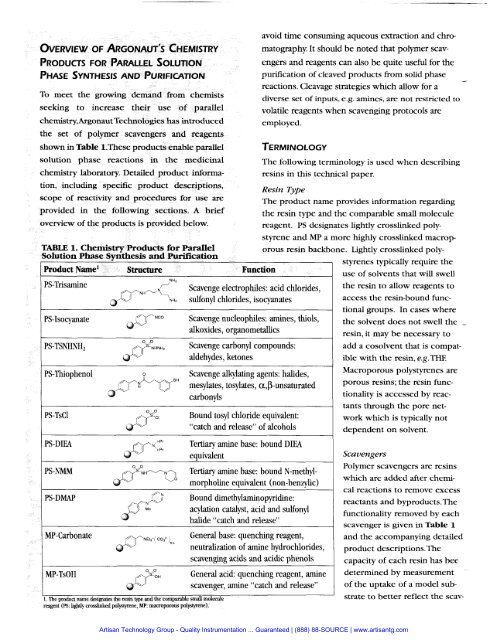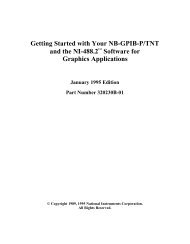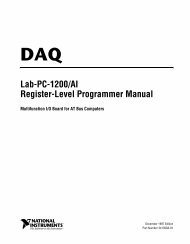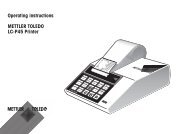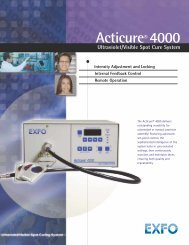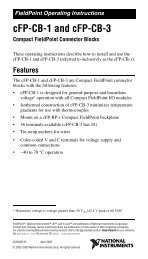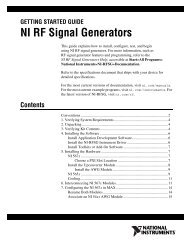Argonaut Quest Training Workshop 2 (pdf) - Artisan Scientific
Argonaut Quest Training Workshop 2 (pdf) - Artisan Scientific
Argonaut Quest Training Workshop 2 (pdf) - Artisan Scientific
Create successful ePaper yourself
Turn your PDF publications into a flip-book with our unique Google optimized e-Paper software.
OVERVIEW OF ARGONAUT'S CHEMISTRYPRODUCTS FOR PAWEL SOLUTIONPHASE SYNTHESIS AND PUR~FJCATIONTo meet the growing demand from chemistsseeking to increase their use of parallelchemistry, <strong>Argonaut</strong> Technologies has introducedthe set of polymer scavengers and reagentsshown in Table 1.These products enable parallelsolution phase reactions in the medicinalchemistry laboratory. Detailed product information,including specitic product descriptions,scope of reactivity and procedures for use areprovided in the following sections. A briefoverview of the products is provided below.1. Chemistry Products for Paralleln Phase Synthesis and PurificationProduct Name1 Structure FunctionPS-Trisamine~ N H - N i ~ ~ zavoid time consuming aqueous extraction and chro-matography. It should be noted that polymer scav-engers and reagents can also be quite useful for thepurification of cleaved products from solid phasereactions. Cleavage strategies which allow for adiverse set of inputs, e.g. arnines, are not restricted tovolatile reagents when scavenging protocols areemployed.TERMINOLOGYScavenge electrophiles: acid chlorides,sulfonyl chlorides, isocyanatesPS-Isocyanate NCO Scavenge nucleophiles: mines, thiols,alkoxides, organometalhcsPS-TSNHNH2PS-ThiophenolPS-TsC1PS-DIEAPS-NMMPS-DMAPMP-CarbonateMP-TsOH9. ,o s. NHNH. Scavenge carbonyl compounds:aldehydes, ketonesQhsn0 0s,,Scavenge alkylating agents: halides,mesylates, tosylates, a,bunsaturatedcarbonylsThe following terminology is used when describingresins in this technical paper.Resin TypeThe product name provides information regardingthe resin type and the comparable small moleculereagent. PS designates lightly crosslinked polystyreneand MP a more highly crosslinked macroporousresin backbone. Lightly crosslinked poly-- -Bound tosyl chloride equivalent:"catch and release" of alcohols,I-PrN\ I-PrTertiary amine base: bound DIEAequivalent--9. 0S ~ N H - N ~ Tertiary amhe base: bound N-methyimorpholineequivalent (non-benzylic)Na-Bound dimethylaminopyridine:Meacylation catalyst, acid and sulfonylhalide "catch and release"NEI,+( CO,~ )General base: quenching reagent,0 5neutralization of amine hydrochlorides,scavenging acids and acidic phenols0~. 0s'tOH1. The produd name des~giates the resin type and the co~nparabk small moteculermgeni (PS: Lghtly croshked poIystyrene, MP: macroporous polystyrene).General acid: quenching reagent, aminescavenger, mine "catch and release"styrenes typically require theuse of solvents that will swellthe resin to allow reagents toaccess the resin-bound functionalgroups. In cases wherethe solvent does not swell the -resin, it may be necessary toadd a cosolvent that is compatiblewith the resin, e.g.THF.Macroporous polystyrenes areporous resins; the resin functionalityis accessed by reactantsthrough the pore networkwhich is typically notdependent on solvent.ScavengersPolymer scavengers are resinswhich are added after chernicalreactions to remove excessreactants and byproducts.Thefunctionality removed by eachscavenger is given in Table 1and the accompanying detailedproduct descriptions. Thecapacity of each resin has beedetermined by measurementof the uptake of a model substrateto better reflect the scav-<strong>Artisan</strong> Technology Group - Quality Instrumentation ... Guaranteed | (888) 88-SOURCE | www.artisantg.com


